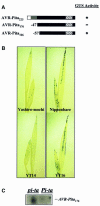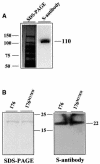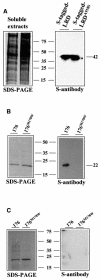Direct interaction of resistance gene and avirulence gene products confers rice blast resistance
- PMID: 10921881
- PMCID: PMC306585
- DOI: 10.1093/emboj/19.15.4004
Direct interaction of resistance gene and avirulence gene products confers rice blast resistance
Abstract
Rice expressing the Pi-ta gene is resistant to strains of the rice blast fungus, Magnaporthe grisea, expressing AVR-Pita in a gene-for-gene relationship. Pi-ta encodes a putative cytoplasmic receptor with a centrally localized nucleotide-binding site and leucine-rich domain (LRD) at the C-terminus. AVR-Pita is predicted to encode a metalloprotease with an N-terminal secretory signal and pro-protein sequences. AVR-Pita(176) lacks the secretory and pro-protein sequences. We report here that transient expression of AVR-Pita(176) inside plant cells results in a Pi-ta-dependent resistance response. AVR-Pita(176) protein is shown to bind specifically to the LRD of the Pi-ta protein, both in the yeast two-hybrid system and in an in vitro binding assay. Single amino acid substitutions in the Pi-ta LRD or in the AVR-Pita(176) protease motif that result in loss of resistance in the plant also disrupt the physical interaction, both in yeast and in vitro. These data suggest that the AVR-Pita(176) protein binds directly to the Pi-ta LRD region inside the plant cell to initiate a Pi-ta-mediated defense response.
Figures






References
-
- Ausubel F.M., Brent,R., Kingston,R.E., Moore,D.D., Smith,J.A., Seidman,J.G. and Struhl,K. (eds) (1987) Protocols in Molecular Biology. John Wiley and Sons, New York, NY.
-
- Bonas U. and van den Ackerveken,G. (1997) Recognition of bacterial avirulence proteins occurs inside the plant cell: a general phenomenon in resistance to bacterial disease? Plant J., 12, 1–7. - PubMed
MeSH terms
Substances
LinkOut - more resources
Full Text Sources
Other Literature Sources
Research Materials
Miscellaneous

